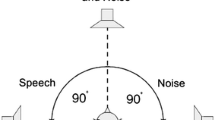Abstract
Purpose
Single-sided deafness (SSD) is a condition where an individual has non-functional hearing in one ear and receives no clinical benefit from amplification in that ear, with the contralateral ear possessing normal audiometric function. Cochlear implant presents a good choice in rehabilitation of SSD. The presence of a deficient cochlear nerve (CN) has been linked to poor performance with cochlear implants. CN can be measured by imaging techniques. The objective of this study was to compare CN diameter in patients who had a history of single-sided deafness because of sudden hearing loss.
Methods
Retrospective study where radiologist was blind designed. 53 SSD patients who had a history of sudden hearing loss and MRI at least 5 years after the sudden hearing loss were included in this retrospective study. High-resolution 3-D constructive interference in steady state (CISS)-sequence magnetic resonance (MRI) images was review by the neurotology-experienced blind radiologist. Vertical, horizontal and area measurements of cochlear nerve between the deaf and the normal ear were made.
Results
There was no statistically significant difference between the normal ear and deaf ear of the subjects in terms of cochlear nerve vertical diameter, horizontal diameter and area. (respectively, p = 0.250; p = 0.183; p = 0.874)
Conclusion
The numbers of remaining cochlear neurons and spiral ganglion cells in the implanted deaf ears are critical and evidence was not found for spiral ganglion cell loss in the sudden hearing loss deaf ear with SSD in MRI. In the light of all these findings, implantation would be a good choice for rehabilitation in postlingual SSD regardless of auditory deprivation duration.

Similar content being viewed by others
References
Härkönen K, Kivekäs I, Rautiainen M, Kotti V, Sivonen V, Vasama JP (2015) Single-sided deafness: the effect of cochlear implantation on quality of life, quality of hearing, and working performance. ORL J Otorhinolaryngol Relat Spec 77(6):339–345. https://doi.org/10.1159/000439176
Katsushika M, Kashio A, Ogata E, Akamatsu Y, Hoshi Y, Iwasaki S, Yamasoba T (2018) Outcomes of cochlear implantations for mumps deafness: a report of four pediatric cases. Int J Pediatr Otorhinolaryngol 114:76–79. https://doi.org/10.1016/j.ijporl.2018.08.027
Dwyer NY, Firszt JB, Reeder RM (2014) Effects of unilateral input and mode of hearing in the better ear: self-reported performance using the speech, spatial and qualities of hearing scale. Ear Hear 35(1):126–136. https://doi.org/10.1097/AUD.0b013e3182a3648b
Persson P, Harder H, Arlinger S, Magnuson B (2001) Speech recognition in background noise: monaural versus binaural listening conditions in normal-hearing patients. Otol Neurotol 22(5):625–630. https://doi.org/10.1097/00129492-200109000-00011
Noble W, Gatehouse S (2004) Interaural asymmetry of hearing loss, speech, spatial and qualities of hearing scale (SSQ) disabilities, and handicap. Int J Audiol 43(2):100–114. https://doi.org/10.1080/14992020400050015
Niparko JK, Cox KM, Lustig LR (2003) Comparison of the bone anchored hearing aid implantable hearing device with contralateral routing of offside signal amplification in the rehabilitation of unilateral deafness. Otol Neurotol 24:73–78. https://doi.org/10.1097/00129492-200301000-00015
Hol MK, Kunst SJ, Snik AF, Cremers CW (2010) Pilot study on the effectiveness of the conventional CROS, the transcranial CROS and the BAHA transcranial CROS in adults with unilateral inner ear deafness. Eur Arch Otorhinolaryngol 267:889–896. https://doi.org/10.1007/s00405-009-1147-9
Arndt S, Aschendorff A, Laszig R, Beck R, Schild C, Kroeger S, Ihorst G, Wesarg T (2011) Comparison of pseudobinaural hearing to real binaural hearing rehabilitation after cochlear implantation in patients with unilateral deafness and tinnitus. Otol Neurotol 32:39–47. https://doi.org/10.1097/MAO.0b013e3181fcf271
Tokita J, Dunn C, Hansen MR (2014) Cochlear implantation and single-sided deafness. Curr Opin Otolaryngol Head Neck Surg 22(5):353–358. https://doi.org/10.1097/MOO.0000000000000080
Vlastarakos PV, Nazos K, Tavoulari EF, Nikolopoulos TP (2014) Cochlear implantation for single-sided deafness: the outcomes. An evidence-based approach. Eur Arch Otorhinolaryngol 271:2119–2126. https://doi.org/10.1007/s00405-013-2746-z
Kim BG, Chung HJ, Park JJ, Park S, Kim SH, Choi JY (2013) Correlation of cochlear nerve size and auditory performance after cochlear implantation in postlingually deaf patients. JAMA Otolaryngol Head Neck Surg 139:604–609. https://doi.org/10.1001/jamaoto.2013.3195
Glastonbury CM, Davidson HC, Harnsberger HR et al (2002) Imaging findings of cochlear nerve deficiency. Am J Neuroradiol 23:635–643
Casselman JW, Offeciers FE, Govaerts PJ et al (1997) Aplasia and hypoplasia of the vestibulocochlear nerve: diagnosis with MR imaging. Radiology 202:773–781. https://doi.org/10.1148/radiology.202.3.9051033
Stjernholm C, Muren C (2002) Dimensions of the cochlear nerve canal: a radioanatomic investigation. Acta Otolarynogol 122:43–48. https://doi.org/10.1080/00016480252775724
Adunka OF, Roush PA, Teagle HF et al (2006) Internal auditory canal morphology in children with cochlear nerve deficiency. Otol Neurotol 27:793–801. https://doi.org/10.1097/01.mao.0000227895.34915.94
Govaerts PJ, Casselman J, Daemers K et al (2003) Cochlear implants in aplasia and hypoplasia of the cochleovestibular nerve. Otol Neurotol 24:887–891. https://doi.org/10.1097/00129492-200311000-00011
Russo EE, Manolidis S, Morriss MC (2006) Cochlear nerve size evaluation in children with sensorineural hearing loss by high-resolution magnetic resonance imaging. Am J Otolaryngol 27(3):166–172. https://doi.org/10.1016/j.amjoto.2005.09.007
Lipschitz N, Kohlberg GD, Scott M, Greinwald JH Jr (2019) Imaging findings in pediatric single-sided deafness and asymmetric hearing loss. Laryngoscope. https://doi.org/10.1002/lary.28095
Nadol JB, Xu WZ (1992) Diameter of the cochlear nerve in deaf humans: implications for cochlear implantation. Ann Otol Rhinol Laryngol 101:988–993. https://doi.org/10.1177/000348949210101205
Author information
Authors and Affiliations
Corresponding author
Ethics declarations
Conflict of interest
There were no conflict of any kind for any author, all authors have contributed to and approved this manuscript. There is no conflict of interest. Research involve human participants and ethical approval was taken from the ethical committee. No funding has been used for this study. This study has been presented in 41th Turkish National ENT Congress 13–17 November 2019 in Antalya, Turkey.
Additional information
Publisher's Note
Springer Nature remains neutral with regard to jurisdictional claims in published maps and institutional affiliations.
Rights and permissions
About this article
Cite this article
Islamoglu, Y., Kesici, G.G., Ercan, K. et al. Single-sided deafness after sudden hearıng loss: late effect on cochlear nerve size. Eur Arch Otorhinolaryngol 277, 2423–2426 (2020). https://doi.org/10.1007/s00405-020-05977-x
Received:
Accepted:
Published:
Issue Date:
DOI: https://doi.org/10.1007/s00405-020-05977-x




